Receptive field properties of neurons in the macaque anterior intraparietal area
- PMID: 26792887
- PMCID: PMC4808117
- DOI: 10.1152/jn.01037.2014
Receptive field properties of neurons in the macaque anterior intraparietal area
Abstract
Visual object information is necessary for grasping. In primates, the anterior intraparietal area (AIP) plays an essential role in visually guided grasping. Neurons in AIP encode features of objects, but no study has systematically investigated the receptive field (RF) of AIP neurons. We mapped the RF of posterior AIP (pAIP) neurons in the central visual field, using images of objects and small line fragments that evoked robust responses, together with less effective stimuli. The RF sizes we measured varied between 3°(2)and 90°(2), with the highest response either at the fixation point or at parafoveal positions. A large fraction of pAIP neurons showed nonuniform RFs, with multiple local maxima in both ipsilateral and contralateral hemifields. Moreover, the RF profile could depend strongly on the stimulus used to map the RF. Highly similar results were obtained with the smallest stimulus that evoked reliable responses (line fragments measuring 1-2°). The nonuniformity and dependence of the RF profile on the stimulus in pAIP were comparable to previous observations in the anterior part of the lateral intraparietal area (aLIP), but the average RF of pAIP neurons was located at the fovea whereas the average RF of aLIP neurons was located parafoveally. Thus nonuniformity and stimulus dependence of the RF may represent general RF properties of neurons in the dorsal visual stream involved in object analysis, which contrast markedly with those of neurons in the ventral visual stream.
Keywords: anterior intraparietal cortex; receptive field; stimulus dependence.
Copyright © 2016 the American Physiological Society.
Figures
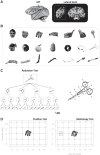
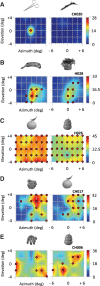
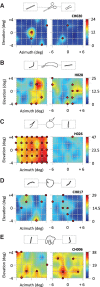



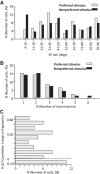

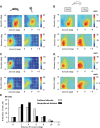

References
-
- Ben Hamed S, Duhamel JR, Bremmer F, Graf W. Representation of the visual field in the lateral intraparietal area of macaque monkeys: a quantitative receptive field analysis. Exp Brain Res 140: 127–144, 2001. - PubMed
-
- Ben Hamed S, Duhamel JR, Bremmer F, Graf W. Visual receptive field modulation in the lateral intraparietal area during attentive fixation and free gaze. Cereb Cortex 12: 234–245, 2002. - PubMed
-
- Castiello U. The neuroscience of grasping. Nat Rev Neurosci 6: 726–736, 2005. - PubMed
Publication types
MeSH terms
LinkOut - more resources
Full Text Sources
Other Literature Sources
Miscellaneous

